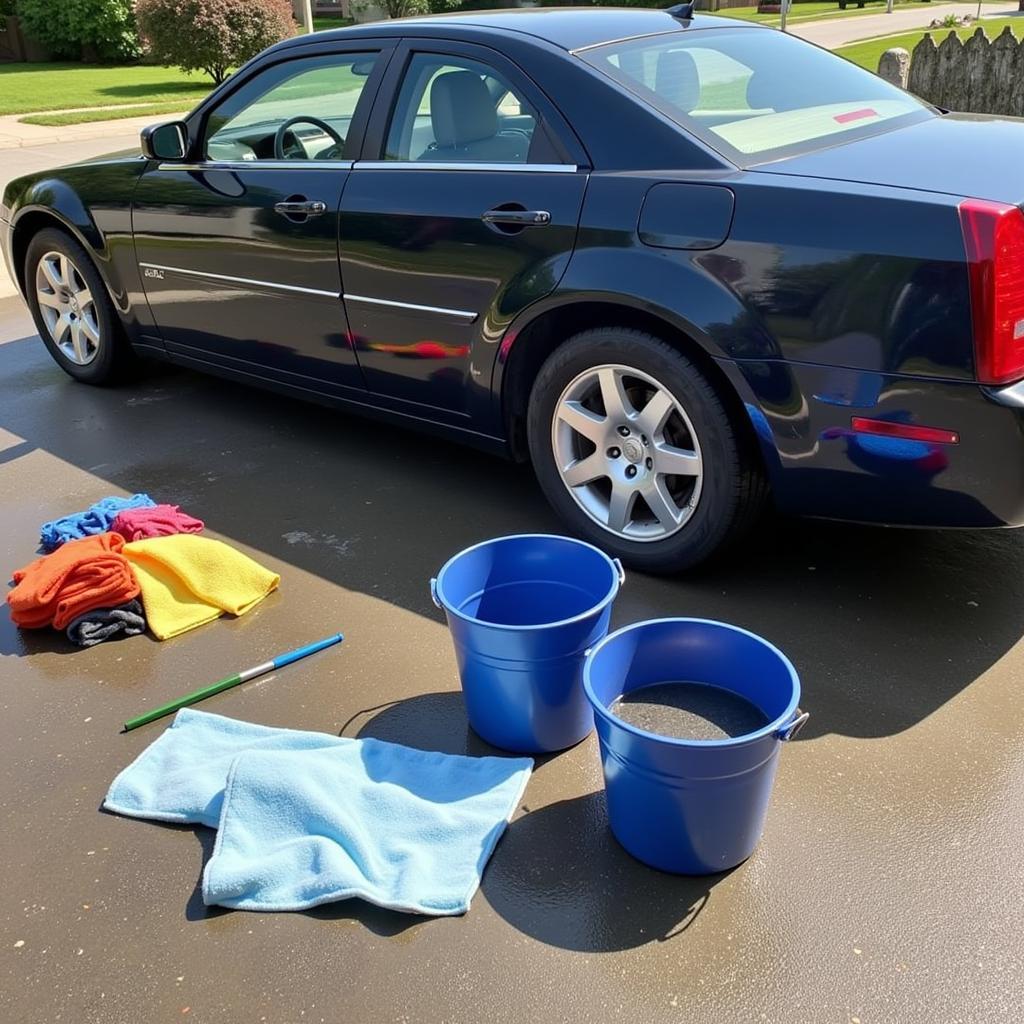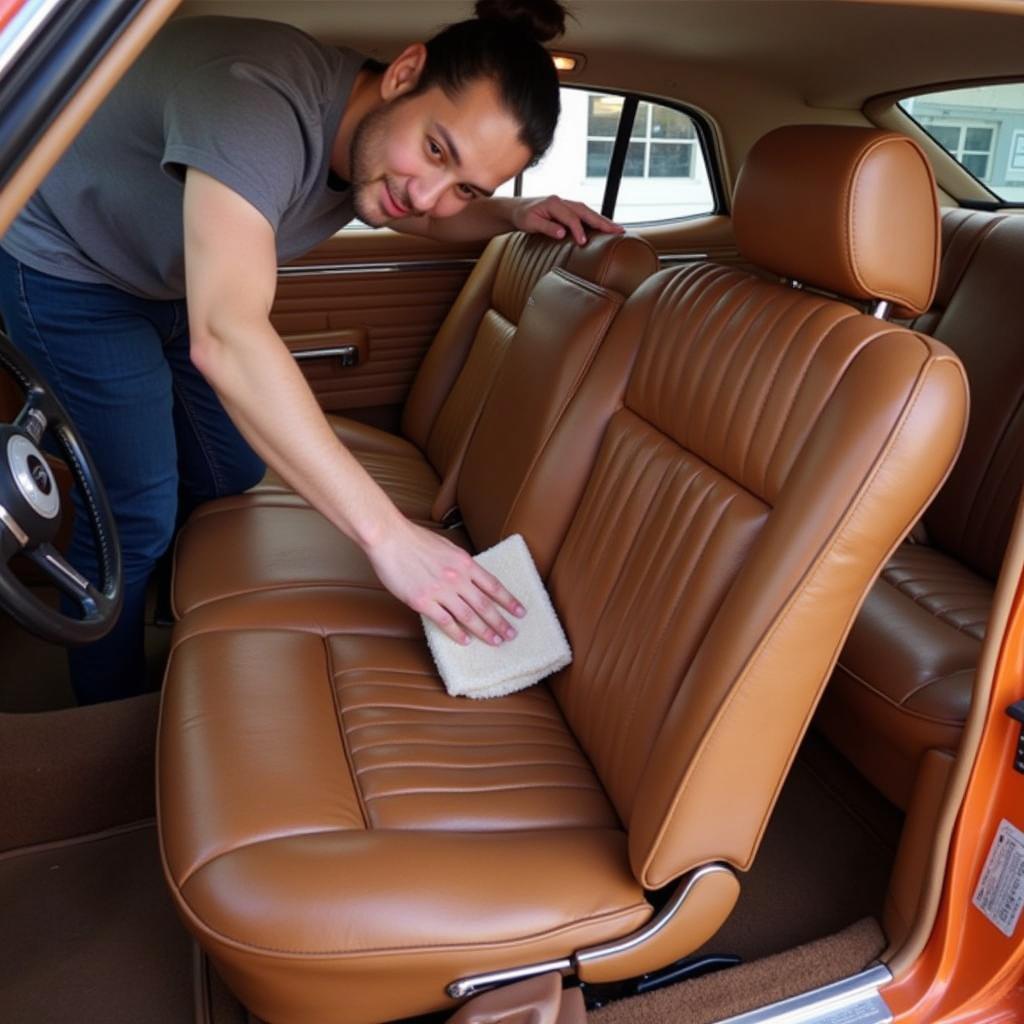Detailing a classic car is more than just a wash and wax; it’s an art form. It’s about preserving history, enhancing beauty, and protecting an investment. This guide will walk you through the process of How To Detail A Classic Car, ensuring your prized possession receives the care and attention it deserves. You’ll learn the techniques and products to use, and understand why a classic car demands a gentler approach than your average daily driver.
Whether your classic is a vintage Rolls-Royce or a muscle car from the golden age, the principles of detailing remain the same: meticulous cleaning, careful polishing, and protective sealing. However, classic cars often have unique characteristics – delicate paint, chrome trim, and sensitive materials – that require specialized attention. This guide will address those specific needs and provide a roadmap to a concours-worthy finish. what does detail your car mean
Prepping Your Classic for Detailing
Before you even think about touching your classic with soap and water, proper preparation is key. Start by finding a shaded area, away from direct sunlight. This prevents water spots and premature drying of cleaning solutions. Gather all your supplies: microfiber towels, car wash soap formulated for classic car paint, wheel cleaner, a wash mitt, detailing brushes, and buckets. Remember, two buckets are essential – one for soapy water and one for rinsing your mitt. This prevents cross-contamination and swirling.
Why Two Buckets are Crucial
Using two buckets is a cornerstone of safe washing, especially for classic car detailing. One bucket holds your car wash solution, and the other contains clean rinse water. After each pass over the car’s surface, dip the wash mitt into the rinse bucket to remove dirt and grime before reloading it with soap. This simple process significantly reduces the risk of scratching your classic car’s finish.
 Classic Car Wash Setup with Two Buckets and Supplies
Classic Car Wash Setup with Two Buckets and Supplies
Washing and Drying Your Classic Beauty
Washing a classic car is a gentle dance, not a power wash. Use a low-pressure stream of water to rinse off loose dirt and debris. Next, using your wash mitt and the two-bucket method, carefully wash the car in sections, starting from the top and working your way down. is car detailing necessary Pay extra attention to areas where dirt tends to accumulate, like around the trim and emblems. Rinse frequently and avoid scrubbing too hard, especially on older paint. Once the washing is complete, dry the car immediately using clean, dry microfiber towels. Blot the water instead of wiping to prevent scratching.
Dealing with Delicate Chrome
Classic cars are often adorned with beautiful chrome trim. However, this chrome can be susceptible to pitting and corrosion. Use a dedicated chrome cleaner and a soft detailing brush to gently clean these areas. Avoid harsh chemicals or abrasive pads. For stubborn stains, try a chrome polish followed by a protective sealant.
Polishing and Protecting Your Classic Investment
Polishing a classic car is about enhancing the paint, not removing it. Unlike modern clear coats, older paints are often single-stage and more delicate. Use a fine-grade polish specifically designed for classic cars and apply it with a soft polishing pad using a dual-action polisher or by hand. how to detail classic car engine bay This will remove minor imperfections and restore shine. After polishing, apply a high-quality wax or sealant to protect the paint and provide a long-lasting finish.
“A classic car’s paint is a testament to its history,” says renowned classic car expert, Arthur Bentley, “Polishing and protecting it is not just about aesthetics, but about preserving that history for generations to come.”
Interior Detailing: Preserving the Past
The interior of a classic car often features unique materials like leather, vinyl, and wood. Each requires specific care. Use a leather cleaner and conditioner to nourish and protect leather seats. Clean vinyl surfaces with a dedicated vinyl cleaner and protect them with a UV protectant. Wood trim should be cleaned with a gentle wood cleaner and polished with a wood polish. “The interior is where you connect with the car,” adds Bentley. “Maintaining its originality adds to the driving experience.”
 Detailing the Leather Interior of a Classic Car
Detailing the Leather Interior of a Classic Car
Conclusion
Detailing a classic car is a labor of love. It’s about appreciating the craftsmanship and preserving the legacy of these automotive masterpieces. By following these steps and using the right products, you can keep your classic car looking its best for years to come. Remember to always research and understand the specific needs of your classic car’s make, model, and year. what are car detailing services This will ensure you’re giving it the best possible care.
FAQs
- What type of soap should I use on a classic car? Use a pH-neutral car wash soap specifically formulated for classic car paint.
- Can I use a pressure washer on a classic car? Avoid high-pressure washers as they can damage older paint. A gentle stream of water is best.
- How often should I detail my classic car? Ideally, a full detail should be performed twice a year.
- What’s the best way to protect chrome trim? Use a chrome polish followed by a sealant designed for chrome.
- How can I prevent swirl marks when washing? Use the two-bucket method and high-quality microfiber towels.
- Is it safe to use modern waxes on classic paint? Choose waxes or sealants specifically designed for classic cars.
- Should I detail the engine bay of a classic car? Yes, but with extra caution and appropriate cleaning products.
“Regular detailing is an investment in your classic car’s future,” advises Bentley. “It helps maintain its value and ensures it remains a source of pride and enjoyment.”
Need help? Contact us via WhatsApp: +1(641)206-8880, Email: [email protected]. We have a 24/7 customer support team.

Leave a Reply